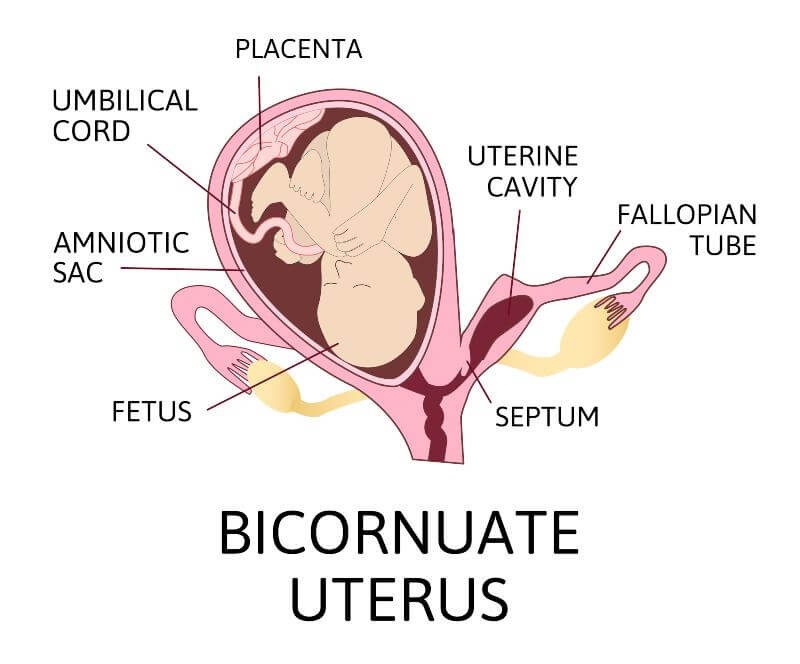The uterus bicornis or bicornuate uterus is an uncommon medical condition, have you ever heard of a bicornuate uterus? A two horned uterus? What is it? Does it affect reproduction? Many questions resonate hearing about this type of uterus.
The uterus in the female body is the organ in which the fertilized egg grows and develops into a fetus.it is known that the uterine shape varies from woman to woman and this is completely normal.
What is a uterus bicornis?
It is a birth defect in which the uterus develops in a heart-shaped manner, containing two cavities “horns”, while an anatomically normal uterus contains one cavity.
Congenital uterine defects are relatively rare, about 3% of women are born with a defect in size, shape, or structure of the uterus. The bicornuate uterus is one of the most common congenital uterine defects. Research showed that women with a bicornuate uterus have a higher incidence of problems such as abortion and premature birth however, having a bicornuate uterus does not rule out the success of pregnancy and natural birth.
Uterus bicornis symptoms
About 3% of women have an abnormal uterine shape. This percentage includes many abnormalities such as changes in uterine size, uterine structure or shape. The presence of a heart (bicornuate) uterus is one of the most common of these types.
However, a woman with a two-horned uterus may have some of the following symptoms.
- Irregular vaginal bleeding.
- Recurrent abortion.
- Painful periods.
- Intermittent abdominal pain.
- Pain during intercourse
It should be noted that many women whose bicornuate uterus was diagnosed did not feel any symptoms but were identified by chance during ultrasound scans for pregnancy purposes.
Causes of uterus bicornis
The female uterus develops when she is in her mother's womb. The bicornuate uterus is a result of the mesonephric ducts failing to fuse together during development and the uterus forms two entities. It is impossible to prevent or stop it.
bicornuate uterus Diagnosis
Here are the examinations that may diagnose the bicornuate uterus
Pelvic examination
Pelvic examination is the examination of the external genitalia and internal reproductive organs. The doctor first inspects the outer genitalia labia minora, labia majora and the clitoris then inserts one or two fingers inside the vagina while pressing on the lower abdomen with the other hand to feel the size, structure, location and tenderness of the uterus.
Ultrasound
A bicornuate uterus can be diagnosed by ultrasound.
Laparoscopy
Laparoscopy can detect the outer shape of the uterus.
Hysteroscopy
Hysteroscopy is a very important form of endoscopy that shows us the inside of the cervix and uterus.
MRI
Magnetic resonance imaging.
Bicornuate uterus Radiology
A Bicornuate uterus is usually detected during a doctor's visit to treat recurrent abortions or delayed reproduction, examining and performing necessary scans showing the presence of a heart shaped uterus.
uterus bicornis and pregnancy

The uterus bicornis does not affect fertility and does not reduce women's chances of pregnancy, according to several researches, the presence of a bicornuate uterus does not affect egg fertilization or implantation in the endometrium lining.
If the deformity is slight, there is a high probability that the shape of the uterus will not affect pregnancy many women with the condition are safely brought to term and have a healthy child.
If the bicornuate deformity is extended to the cervix carrying a child to term is only 60 percent. Extra care and follow up is needed in such patients.
The uterine malformation of the uterus was found not to prevent pregnancy or implantation of the embryos in the uterus.
Bicornuate uterus treatment
There is no medical treatment for a bicornuate uterus, but in some cases, surgery is used to correct the uterus bicornis. In women with a history of miscarriage, one study showed that 88% of those who underwent uterine correction were able to conceive and deliver successfully. However, most women with a bicornuate (two horned) uterus do not need surgery because it does not usually affect women's pregnancy chances.






